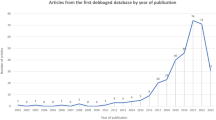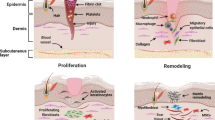Abstract
Introduction and hypothesis
Collagen has been proposed to be a useful biomaterial, but previous attempts to combine meshes with a collagen membrane have failed. The objective was to verify the effect of high-purified collagen gel coating in the immune-inflammatory response, host collagen metabolism, and angiogenesis around polypropylene mesh.
Methods
In 20 female Wistar rats were implanted, at one side of the abdominal wall, a monofilament polypropylene mesh (PP), and, on the other side, a mesh coated with a new highly purified collagen gel (PPC). The animals were divided into sub-groups and euthanized at 7, 14, 21, and 90 days after implantation. Immunohistochemical analysis was performed using interleukin 1 (IL-1), matrix metalloproteinases (MMP-2, MMP-3), surface antigen CD-31, and tumor necrosis factor (TNF-α). Objective analysis (percent reactive area, average density, and vessels concentration) was performed using AxioVision Software.
Results
Comparative analysis showed: higher vessel density in the PPC group after 14 days (p = 0.002); a decrease in the average density of MMP-2 in the PPC group after 21 and 90 days (p = 0.046); more stability in the behavior of MMP-3 in the PPC group throughout the periods with the percentage reactive area for MMP-3 showing a significant decrease just in the PP group after 14 and 90 days (p = 0.017), and also for MMP-3 average density, in which reduction was significant after 21 days in the PP group, but not until after 90 days in PPC group (p < 0.001).
Conclusions
Highly purified collagen coating causes significant changes in angiogenesis and in the immune reaction of metalloproteinase around mesh implants in rats. These findings can be useful for improving mesh biocompatibility for pelvic floor surgery if such effects could be properly controlled.



Similar content being viewed by others
References
Goldman L, Ausiello D et al (2004) Incontinência urinária. In: Cecil textbook of medicine, 22nd edn. Elsevier, Amsterdam, pp 127–128
Maher C, Baessler K, Glazener CMA, Adams EJ, Hagen S (2008) Surgical management of pelvic organ prolapse in women: a short version Cochrane review. Neurourol Urodyn 27(1):3–12
Cervigni M, Natale F (2001) The use of synthetics in the treatment of pelvic organ prolapse. Curr Opin Urol 11(4):429–435
Patel H, Ostergard DR, Sternschuss G (2012) Polypropylene mesh and the host response. Int Urogynecol J 23(6):669–679. doi:10.1007/s00192–012–1718-y
US Food and Drug Administration (2011) FDA Safety Communication: Update on serious complications associated with transvaginal placement of surgical mesh for pelvic organ prolapse. http://www.fda.gov/medicaldevices/safety/alertsandnotices/ucm262435.htm. Accessed 17 March 2014
National Institute for Health and Clinical Excellence (2008) Surgical repair of vaginal wall prolapse using mesh http://guidance.nice.org.uk/IPG267/Guidance/pdf/English. Accessed 10 February 2014
Guerrete N, Peterson TV, Aguirre OA, VanDrie DM, Biller DH, Davila GW (2009) Anterior repair with or without collagen matrix reinforcement. A randomized controlled trial. Obstet Gynecol 114(1):59–65. doi:10.1097/AOG.0b013e3181a81b41
Huffaker RK, Muir TW, Rao A et al (2008) Histologic response of porcine collagen-coated and uncoated polypropylene grafts in a rabbit vaginal model. Am J Obstet Gynecol 198(5):582. doi:10.1016/j.ajog.2007.12.029
De Tayrac R, Alves A, Thérin M (2007) Collagen-coated vs noncoated low-weight polypropylene meshes in a sheep model for vaginal surgery. A pilot study. Int Urogynecol J Pelvic Floor Dysfunct 18(5):513–520
Knapp TR, Luck E, Daniels JR (1977) Behavior of solubilized collagen as a bioimplant. J Surg Res 23(2):96–105
Vidal BC (1995) From collagen type I solution to fibers with a helical pattern: a self-assembly phenomenon. C R Acad Sci III 318(8):831–836
Vidal BC (2003) Image analysis of tendon helical superstructure using interference and polarized light microscopy. Micron 34(8):423–432
Vidal BC (2010) Form birefringence as applied to biopolymer and inorganic material supraorganization. Biotech Histochem 85(6):365–378. doi:10.3109/10520290903430496
Chvapil M, Kronenthal RL, Van Winkle W Jr (1973) Medical and surgical application of collagen. Int Rev Connect Tissue Res 6:1–61
Lukasiewicz A, Skopinska-Wisniewska J, Marszalek A, Molski S, Drewa T (2013) Collagen/polypropylene composite mesh biocompatibility in abdominal wall reconstruction. Plast Reconstr Surg 131:731e–740e. doi:10.1097/PRS.0b013e3182865d2c
Parenteau-Bareil R, Gauvin R, Berthod F (2010) Collagen based biomaterials for tissue engineering applications. Materials 3(3):1863–1887. doi:10.3390/ma3031863
Kuiper N, Gabriel N, Griffiths S, Tew S (2008) Shaping and sensing the extracellular matrix. Int J Exp Pathol 89:A1–A29
Maturana LG, Zanon RG, Pierucci A, Vidal BC, Oliveira AL (2011) Supraorganized collagen enhances Schwann cell reactivity and organization in vitro. Braz J Med Biol Res 44(7):682–687
Cervigni M, Natale F, La Penna C, Saltari M, Padoa A, Agostini M (2011) Collagen-coated polypropylene mesh in vaginal prolapsed surgery: an observational study. Eur J Obstet Gynecol Reprod Biol 156(2):223–227. doi:10.1016/j.ejogrb.2011.01.027
Van’t Riet M, Burger JM, Bonthuis F, Jeekel J, Bonjer HJ (2004) Prevention of adhesion formation to polypropylene mesh by collagen coating: a randomized controlled study in a rat model of ventral hernia repair. Surg Endosc 18(4):681–685
Yung S, Li FK, Chan TM (2006) Peritoneal mesothelial cell culture and biology. Perit Dial Int 26(2):162–173
Schonleben F, Reck T, Tannapfel A, Hohenberger W, Schneider I (2006) Collagen foil (TissuFoil E) reduces the formation of adhesions when using polypropylene mesh for the repair of experimental abdominal wall defects. Int J Color Dis 21(8):840–846. doi:10.1007/s00384-006-0091-z
Siniscalchi RT, Melo M, Palma PC, Dal Fabbro IM, Vidal BC, Riccetto CL (2013) Highly purified collagen coating enhances tissue adherence and integration properties of monofilament polypropylene meshes. Int Urogynecol J 24(10):1747–1754. doi:10.1007/s00192-013-2109-8
Thiel M, Palma PCR, Riccetto CLZ, Dambros M, Netto NR Jr (2005) A stereological analysis of fibrosis and inflammatory reaction induced by four different synthetic slings. BJU Int 95(6):833–837
Page-McCaw A, Ewald AJ, Werb Z (2007) Matrix metalloproteinases and the regulation of tissue remodelling. Nat Rev Mol Cell Biol 8(3):221–233
Birkedal-Hansen H, Moore WG, Bodden MK, Windsor LJ, Birkedal-Hansen B, DeCarlo A, Engler JA (1993) Matrix metalloproteinases: A review. Crit Rev Oral Biol Med 4(2):197–250
Lobmann R, Zemlin C, Motzkau M, Reschke K, Lehnert H (2006) Expression of matrix metalloproteinases and growth factors in diabetic foot wounds treated with a protease absorbent dressing. J Diabetes Complicat 20(5):329–335
Gibson D, Cullen B, Legerstee R, Harding KG, Schultz G (2009) MMPs Made Easy Wounds International; 1(1) http://www.woundsinternational.com
Steffensen B, Häkkinen L, Larjava H (2001) Proteolytic events of wound-healing–coordinated interactions among matrix metalloproteinases (MMPs), integrins, and extracellulr matrix molecules. Crit Rev Oral Biol Med 12(5):373–398
Bullard KM, Lund L, Mudgett JS, Mellin TN, Hunt TK, Murphy B, Ronan J, Werb Z, Banda MJ (1999) Impaired wound contraction in stromelysin-1-deficient mice. Ann Surg 230(2):260–265
Acknowledgments
We thank FAPESP (Research Support Foundation of São Paulo State) for the financial support for the execution of this research project (process number 2013/05,841–3).
Conflicts of interest
None.
Authors’ contributions to the manuscript
F.G.F. Dias: data collection, manuscript writing; A. Prudente: data collection; R.T. Siniscalchi: data collection; B.C. Vidal: project development; C.L.Z. Riccetto: project development, manuscript writing.
Author information
Authors and Affiliations
Corresponding author
Rights and permissions
About this article
Cite this article
Dias, F.G.F., Prudente, A., Siniscalchi, R.T. et al. Can highly purified collagen coating modulate polypropylene mesh immune-inflammatory and fibroblastic reactions? Immunohistochemical analysis in a rat model. Int Urogynecol J 26, 569–576 (2015). https://doi.org/10.1007/s00192-014-2529-0
Received:
Accepted:
Published:
Issue Date:
DOI: https://doi.org/10.1007/s00192-014-2529-0




